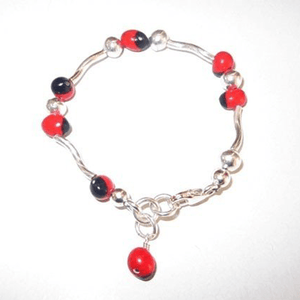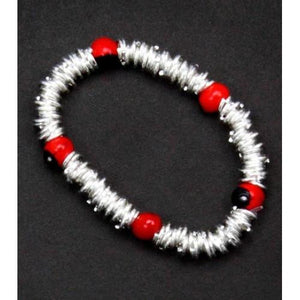Latest News Latest News
Writing Jewelry descriptions for your online shop Writing Jewelry descriptions for your online shop
As holidays are approaching SOON, Is your website ready to drive customers to buy your products, have you checked everything is working well? writing jewelry descriptions for an online jewelry shop it is always been a tedious process. Not to mention brain exhausting. Especially cause you have to find words that google and other search engines would recognize so your customers can find you. While I am not an expert (although a lot of reading is recommended ) I have become better and better at the science of writing jewelry descriptions and I decided to share what I have learned:
Simple steps you should not forget when writing product descriptions:
1. Write a title or headline for the description that catches the eye and uses terms that customers might search for, such as “Sterling silver red swirl drop earrings” 
2. Specify exactly what is being sold in the listing – for example, a single set of earrings, or a necklace-and-earring set. “Handmade Necklace and Earring Set Red jewelry.”
3.
List what the necklace, bracelet, anklet or earrings are made of and the names of the beads, stones, and/or pendants (hand-picked natural red seeds)
4. Include details about the jewelery’s size (VERY IMPORTANT) so customers can visualize their purchase. Give the length of the strand from end to end or the earring length (and specify where the measurement starts–such as “from the bottom of the earwire.”) Specify the sizes, in millimeters, of the major pieces that comprise the jewelry, including the primary beads, any dangles or pendants, type and measurement of the clasp used. This helps customers who may prefer one clasp type over another.
5. Specify the state of the materials–that is, whether they are natural or synthetic or reconstituted or, in the case of turquoise, stabilized, or, in the case of pearls, freshwater or natural. 
6. Include any interesting details about the provenance of the materials in the jewelry description.
7. Add interest to the jewelry description by describing any challenges or inspiration sources you experienced in the making of the jewelry. Anecdotes and stories about the handcrafted pieces for sale can engage customers in jewelry items.
8. Include words that people search for, so your jewelry product listings turn up in the search engines. Describe in detail as much as possible about the jewelry, in the title, in the description, and the tags. Think creatively. Your customers will never find your citrine earrings if they search for “chunky citrine earrings” and you never include the word “chunky”.
9. AVOID
- “Beautiful” – avoid this word. Just like every baby is beautiful to its mother, all jewelry is beautiful to its creator. In most cases, even deliberately odd art jewelry has a beauty of its own. How can such a non-specific word convey the emotions that enhance your product in the eyes of the buyer?
- “Lovely” – only a little better than “beautiful.” It has a softer, more feminine sound, but it’s not terribly connotative.
- “Pretty” – more girlish than the previous two, suggesting a piece for younger women, but also vague
When we’re considering alternates, carefully choosing appropriate terms like the ones in this list, which I’ve tailored to the needs of jewelry sellers but which other online copy-writers may find helpful as well, may help your site stand out:
- Pleasing, graceful, classic, shapely, heirloom-quality, handsome, lustrous –These are an excellent choice for vintage-inspired jewelry and simple, traditional designs because they suggest a slightly vintage, candlelit glamour. Someone who wanted, for instance, classic and traditional wedding jewelry with the “Grandma’s pearls” look would be attracted to jewelry that was accurately described this way.
- Intriguing, alluring, fascinating, enthralling, tantalizing, compelling –These words connote equal parts romance and mystery. They suggest an engaging or even hypnotic effect. They might be particularly appropriate for found-object jewelry, steampunk jewelry, particularly unusual materials or techniques like chainmaille where the structural complexity is important to the appeal.
- Delightful, darling, sparkling, delicious, charming, precious Superb for jewelry that’s either intended for younger women and girls or uses a feminine “cuteness” for its appeal. Consider these for more delicate designs, charm bracelets and necklaces, miniatures of bigger items, or colorful polymer clay, because the connotation of these choices is all about sweetness and fun.
- Splendid, exquisite, magnificent, luxurious, queenly, divine –Perfect diction when you’re selling wedding jewelry or pieces made with very fine materials, directing your customer’s attention to the quality you’ve put into every step. It makes your pieces sound worthy to be crown jewels, perfect for your top-dollar pieces and for advertising custom special-occasion work.
- Luscious, touchable, magnetic, mesmerizing –These guide your customer to recognize a hypnotic, sexy quality. These words have a very sensual connotation, great for dark lustrous colors, Old Hollywood designs, and pin-up curves!
While you’re at it, use the same process to describe your materials:
- Instead of “beautiful pearls,”let it be made of “flawless, unblemished pearls.”
- Instead of “beautiful stones,”describe “handsome glossy stones with intriguing matrix.”
- Instead of “beautiful hand-painted silks,”string it on “graceful diaphanous silks.”
And your colors:
- Instead of just a pretty red,try “lipstick red” for a sensual glamorous piece, “candy red” for a young, energetic one.
- Instead of just a lovely blue,try “delicate dreamy blue” for a story bracelet, or “luxe blue” for a high-end mixed-media piece.
By using more connotative words, not only will your pieces be beautiful, you’ll also make your customers think so too. When the description aptly and vividly mirrors the piece, the unified impressions guide your target customer’s response, leading them to look for the shopping cart!
Don’t feel exhausted after reading this. Trust me I hear you and already know how you are feeling. This takes time but I am pretty sure you will make it work. Just be patient, don’t try to do all at once or all descriptions in one day it will never happen.
Also ask your family and friends to read your descriptions, so you can get some feeback. This may take a while and you will be changing descriptions or refreshing the content as months come by.
So remember little by little Rome was built;)
Hope this helps,
Evelyn,
As holidays are approaching SOON, Is your website ready to drive customers to buy your products, have you checked everything is working well? writing jewelry descriptions for an online jewelry shop it is always been a tedious process. Not to mention brain exhausting. Especially cause you have to find words that google and other search engines would recognize so your customers can find you. While I am not an expert (although a lot of reading is recommended ) I have become better and better at the science of writing jewelry descriptions and I decided to share what I have learned:
Simple steps you should not forget when writing product descriptions:
1. Write a title or headline for the description that catches the eye and uses terms that customers might search for, such as “Sterling silver red swirl drop earrings” 
2. Specify exactly what is being sold in the listing – for example, a single set of earrings, or a necklace-and-earring set. “Handmade Necklace and Earring Set Red jewelry.”
3.
List what the necklace, bracelet, anklet or earrings are made of and the names of the beads, stones, and/or pendants (hand-picked natural red seeds)
4. Include details about the jewelery’s size (VERY IMPORTANT) so customers can visualize their purchase. Give the length of the strand from end to end or the earring length (and specify where the measurement starts–such as “from the bottom of the earwire.”) Specify the sizes, in millimeters, of the major pieces that comprise the jewelry, including the primary beads, any dangles or pendants, type and measurement of the clasp used. This helps customers who may prefer one clasp type over another.
5. Specify the state of the materials–that is, whether they are natural or synthetic or reconstituted or, in the case of turquoise, stabilized, or, in the case of pearls, freshwater or natural. 
6. Include any interesting details about the provenance of the materials in the jewelry description.
7. Add interest to the jewelry description by describing any challenges or inspiration sources you experienced in the making of the jewelry. Anecdotes and stories about the handcrafted pieces for sale can engage customers in jewelry items.
8. Include words that people search for, so your jewelry product listings turn up in the search engines. Describe in detail as much as possible about the jewelry, in the title, in the description, and the tags. Think creatively. Your customers will never find your citrine earrings if they search for “chunky citrine earrings” and you never include the word “chunky”.
9. AVOID
- “Beautiful” – avoid this word. Just like every baby is beautiful to its mother, all jewelry is beautiful to its creator. In most cases, even deliberately odd art jewelry has a beauty of its own. How can such a non-specific word convey the emotions that enhance your product in the eyes of the buyer?
- “Lovely” – only a little better than “beautiful.” It has a softer, more feminine sound, but it’s not terribly connotative.
- “Pretty” – more girlish than the previous two, suggesting a piece for younger women, but also vague
When we’re considering alternates, carefully choosing appropriate terms like the ones in this list, which I’ve tailored to the needs of jewelry sellers but which other online copy-writers may find helpful as well, may help your site stand out:
- Pleasing, graceful, classic, shapely, heirloom-quality, handsome, lustrous –These are an excellent choice for vintage-inspired jewelry and simple, traditional designs because they suggest a slightly vintage, candlelit glamour. Someone who wanted, for instance, classic and traditional wedding jewelry with the “Grandma’s pearls” look would be attracted to jewelry that was accurately described this way.
- Intriguing, alluring, fascinating, enthralling, tantalizing, compelling –These words connote equal parts romance and mystery. They suggest an engaging or even hypnotic effect. They might be particularly appropriate for found-object jewelry, steampunk jewelry, particularly unusual materials or techniques like chainmaille where the structural complexity is important to the appeal.
- Delightful, darling, sparkling, delicious, charming, precious Superb for jewelry that’s either intended for younger women and girls or uses a feminine “cuteness” for its appeal. Consider these for more delicate designs, charm bracelets and necklaces, miniatures of bigger items, or colorful polymer clay, because the connotation of these choices is all about sweetness and fun.
- Splendid, exquisite, magnificent, luxurious, queenly, divine –Perfect diction when you’re selling wedding jewelry or pieces made with very fine materials, directing your customer’s attention to the quality you’ve put into every step. It makes your pieces sound worthy to be crown jewels, perfect for your top-dollar pieces and for advertising custom special-occasion work.
- Luscious, touchable, magnetic, mesmerizing –These guide your customer to recognize a hypnotic, sexy quality. These words have a very sensual connotation, great for dark lustrous colors, Old Hollywood designs, and pin-up curves!
While you’re at it, use the same process to describe your materials:
- Instead of “beautiful pearls,”let it be made of “flawless, unblemished pearls.”
- Instead of “beautiful stones,”describe “handsome glossy stones with intriguing matrix.”
- Instead of “beautiful hand-painted silks,”string it on “graceful diaphanous silks.”
And your colors:
- Instead of just a pretty red,try “lipstick red” for a sensual glamorous piece, “candy red” for a young, energetic one.
- Instead of just a lovely blue,try “delicate dreamy blue” for a story bracelet, or “luxe blue” for a high-end mixed-media piece.
By using more connotative words, not only will your pieces be beautiful, you’ll also make your customers think so too. When the description aptly and vividly mirrors the piece, the unified impressions guide your target customer’s response, leading them to look for the shopping cart!
Don’t feel exhausted after reading this. Trust me I hear you and already know how you are feeling. This takes time but I am pretty sure you will make it work. Just be patient, don’t try to do all at once or all descriptions in one day it will never happen.
Also ask your family and friends to read your descriptions, so you can get some feeback. This may take a while and you will be changing descriptions or refreshing the content as months come by.
So remember little by little Rome was built;)
Hope this helps,
Evelyn,




